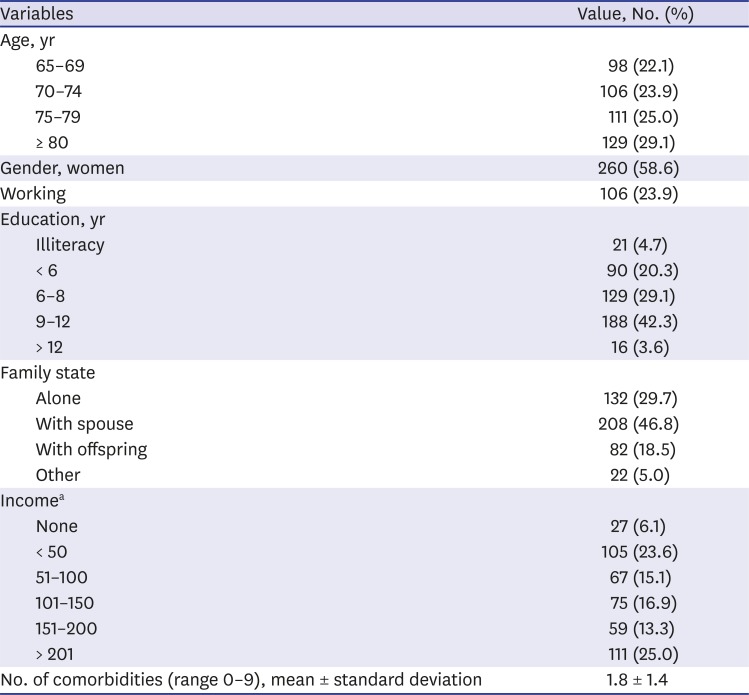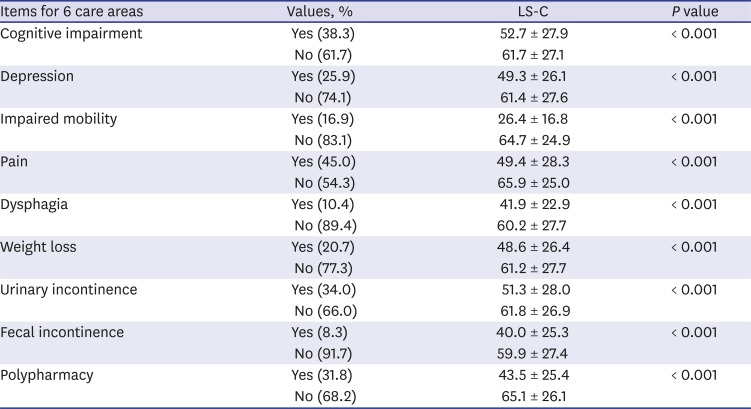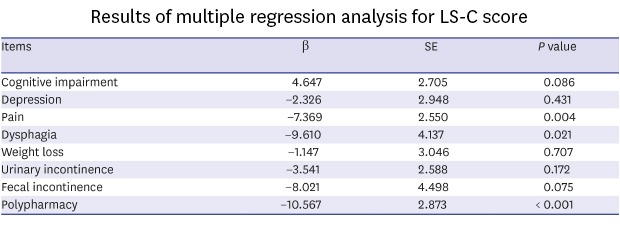2. MacKnight C, Rockwood K. Assessing mobility in elderly people. A review of performance-based measures of balance, gait and mobility for bedside use. Rev Clin Gerontol. 1995; 5(4):464–486.

3. Parker M, Baker PS, Allman RM. A life-space approach to functional assessment of mobility in the elderly. J Gerontol Soc Work. 2001; 35(4):35–55.

4. Harada N, Chiu V, Damron-Rodriguez J, Fowler E, Siu A, Reuben DB. Screening for balance and mobility impairment in elderly individuals living in residential care facilities. Phys Ther. 1995; 75(6):462–469. PMID:
7770493.

5. Chung J, Demiris G, Thompson HJ. Instruments to assess mobility limitation in community-dwelling older adults: a systematic review. J Aging Phys Act. 2015; 23(2):298–313. PMID:
24589525.

6. Melzer D, Lan TY, Guralnik JM. The predictive validity for mortality of the index of mobility-related limitation--results from the EPESE study. Age Ageing. 2003; 32(6):619–625. PMID:
14600003.
7. Baker PS, Bodner EV, Allman RM. Measuring life-space mobility in community-dwelling older adults. J Am Geriatr Soc. 2003; 51(11):1610–1614. PMID:
14687391.

8. May D, Nayak US, Isaacs B. The life-space diary: a measure of mobility in old people at home. Int Rehabil Med. 1985; 7(4):182–186. PMID:
4093250.

9. Tinetti ME, Ginter SF. The nursing home life-space diameter. A measure of extent and frequency of mobility among nursing home residents. J Am Geriatr Soc. 1990; 38(12):1311–1315. PMID:
2254569.
10. Stalvey BT, Owsley C, Sloane ME, Ball K. The Life Space Questionnaire: a measure of the extent of mobility of older adults. J Appl Gerontol. 1999; 18(4):460–478.

11. Hashidate H, Shimada H, Shiomi T, Shibata M, Sawada K, Sasamoto N. Measuring indoor life-space mobility at home in older adults with difficulty to perform outdoor activities. J Geriatr Phys Ther. 2013; 36(3):109–114. PMID:
22976813.

12. Auger C, Demers L, Gélinas I, Routhier F, Jutai J, Guérette C, et al. Development of a French-Canadian version of the Life-Space Assessment (LSA-F): content validity, reliability and applicability for power mobility device users. Disabil Rehabil Assist Technol. 2009; 4(1):31–41. PMID:
19172479.

13. Shimada H, Sawyer P, Harada K, Kaneya S, Nihei K, Asakawa Y, et al. Predictive validity of the classification schema for functional mobility tests in instrumental activities of daily living decline among older adults. Arch Phys Med Rehabil. 2010; 91(2):241–246. PMID:
20159128.

14. Curcio CL, Alvarado BE, Gomez F, Guerra R, Guralnik J, Zunzunegui MV. Life-Space Assessment scale to assess mobility: validation in Latin American older women and men. Aging Clin Exp Res. 2013; 25(5):553–560. PMID:
23949973.

15. Kammerlind AS, Fristedt S, Ernsth Bravell M, Fransson EI. Test-retest reliability of the Swedish version of the Life-Space Assessment Questionnaire among community-dwelling older adults. Clin Rehabil. 2014; 28(8):817–823. PMID:
24509893.

16. Portegijs E, Iwarsson S, Rantakokko M, Viljanen A, Rantanen T. Life-space mobility assessment in older people in Finland; measurement properties in winter and spring. BMC Res Notes. 2014; 7(1):323. PMID:
24886670.

17. Ji M, Zhou Y, Liao J, Feng F. Pilot study on the Chinese version of the Life Space Assessment among community-dwelling elderly. Arch Gerontol Geriatr. 2015; 61(2):301–306. PMID:
26139579.

18. Rantakokko M, Portegijs E, Viljanen A, Iwarsson S, Kauppinen M, Rantanen T. Changes in life-space mobility and quality of life among community-dwelling older people: a 2-year follow-up study. Qual Life Res. 2016; 25(5):1189–1197. PMID:
26407605.

19. Kim YS, Choi J, Moon Y, Park JM, Uhm KE, Lee K, et al. Development of screening tool for the elderly based on 48//6 Model of Care: the Geriatric Screening for Care-10 (GCS-10). Ponte. 2017; 73(7):234–244.
20. Lee Y, Lee HH, Uhm KE, Jung HJ, Kim YS, Shin J, et al. Early identification of risk factors for mobility decline among hospitalized older patients. Am J Phys Med Rehabil. 2019; 98(8):699–705. PMID:
31318751.

21. Kim YS, Han SH, Lee J, Choi J, Park JM, Lee KS, et al. 48/6 Model of Care for senior clinical care management. Korean J Clin Geriatr. 2016; 17(1):7–15.

22. Yang YN, Kim BR, Uhm KE, Kim SJ, Lee S, Oh-Park M, et al. Life Space Assessment in stroke patients. Ann Rehabil Med. 2017; 41(5):761–768. PMID:
29201814.

23. Meldon SW, Mion LC, Palmer RM, Drew BL, Connor JT, Lewicki LJ, et al. A brief risk-stratification tool to predict repeat emergency department visits and hospitalizations in older patients discharged from the emergency department. Acad Emerg Med. 2003; 10(3):224–232. PMID:
12615588.
24. Kenis C, Decoster L, Van Puyvelde K, De Grève J, Conings G, Milisen K, et al. Performance of two geriatric screening tools in older patients with cancer. J Clin Oncol. 2014; 32(1):19–26. PMID:
24276775.

25. Saliba D, Elliott M, Rubenstein LZ, Solomon DH, Young RT, Kamberg CJ, et al. The vulnerable elders survey: a tool for identifying vulnerable older people in the community. J Am Geriatr Soc. 2001; 49(12):1691–1699. PMID:
11844005.

26. Kellen E, Bulens P, Deckx L, Schouten H, Van Dijk M, Verdonck I, et al. Identifying an accurate pre-screening tool in geriatric oncology. Crit Rev Oncol Hematol. 2010; 75(3):243–248. PMID:
20060313.

27. Min LC, Elliott MN, Wenger NS, Saliba D. Higher vulnerable elders survey scores predict death and functional decline in vulnerable older people. J Am Geriatr Soc. 2006; 54(3):507–511. PMID:
16551321.

28. Molina-Garrido MJ, Guillén-Ponce C. Overvaluation of the vulnerable elders survey-13 as a screening tool for vulnerability. J Clin Oncol. 2011; 29(23):3201–3202. PMID:
21747086.

29. Bellera CA, Rainfray M, Mathoulin-Pélissier S, Mertens C, Delva F, Fonck M, et al. Screening older cancer patients: first evaluation of the G-8 geriatric screening tool. Ann Oncol. 2012; 23(8):2166–2172.










 PDF
PDF Citation
Citation Print
Print




 XML Download
XML Download